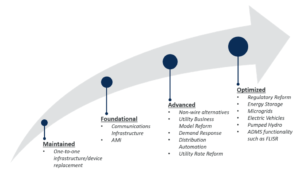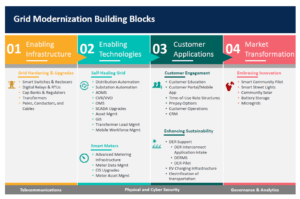
June 27, 2018 | InBrief
Why the grid mod evolution is not a one-size-fits-all endeavor
Why the grid mod evolution is not a one-size-fits-all endeavor
Grid Modernization represents the single largest transformation of the electric utility post-WWII. Investments in hardware and software in the digital age promise a more resilient and reliable grid poised to serve the U.S. well into the 21st century. In this article, we discuss the primary drivers of Grid Mod efforts, how they vary by utility, and how approaches have evolved over time.
The U.S. Department of Energy identifies six pillars in its Grid Modernization Initiative, which we summarize below. The degree to which these pillars can be supported in a business case defines the viable roadmap for a utility Grid Mod program. For example, in Hawaii, high electricity prices and penetration of rooftop solar create a greater opportunity for improving affordability and reliability. In areas that are prone to large storms, improving resiliency is of greater value. Or, for utilities operating within states with high Renewable Portfolio Standards, sustainability, reliability, and flexibility are higher priorities.
Additionally, the scope of a utility’s Grid Mod initiative is determined by a utility’s regulatory framework, the current state of its grid, ownership structure, and degree of competitiveness in the market. The pace of transformation is driven by policy and regulatory requirements, including those defined by state law and regulators, and is compounded by the projection of renewable energy growth and decarbonization goals.
The illustration below depicts the maturity of Grid Mod moving from current state to future state. For utilities that have not seen a proliferation of distributed energy resources (DERs), the business case may not support going far beyond foundational Grid Mod initiatives – at least not in the short term. As a result, much of the industry’s focus on Grid Mod is on one-to-one technology upgrades of existing infrastructure. These investments progress to those that add functionality and services to the grid that would improve performance and reduce costs, such as the deployment of communication devices and controls for distribution automation (DA) and advanced metering infrastructure (AMI).
Utilities in states leading the way in establishing and progressing toward renewable energy goals (e.g. CA, MA, VT, OR, and NY) are undergoing significant transformational change to plan for, and accommodate intermittent and variable renewable energy generation. Technology like AMI helps utilities achieve higher levels of customer engagement and satisfaction. Customers can contribute to grid reliability, flexibility, and sustainability through any combination of demand response, energy efficiency, renewable energy, or electric vehicles, while utilities can leverage AMI to track energy usage, efficiency improvements, and demand response at the same time. Furthermore, AMI enables innovative pricing structures and/or real-time pricing that can drive customer technology adoption of behind the meter solar photovoltaics and storage, as well as behavioral changes, to relieve load congestion, better balance supply and demand, and improve reliability.
One of the challenges to utilities ismanaging and prioritizing a multitude of Grid Mod investments and efforts across its organization – requiring both internal and external changes to the organization. We find that developing the overarching strategy, engaging stakeholders, and defining actionable and measurable objectives leads to successful implementation that ultimately delivers value to customers. By taking a step back and developing a holistic strategy first, utilities will be better prepared to define more value-driven initiatives with regulatory and public support while remaining nimble to market changes and technology adoption.




